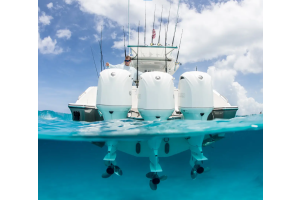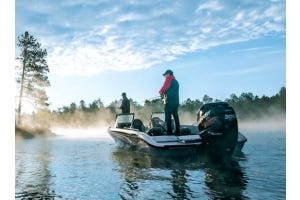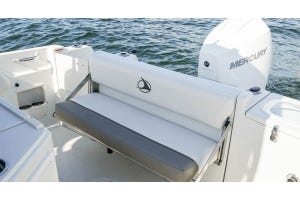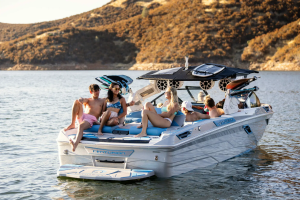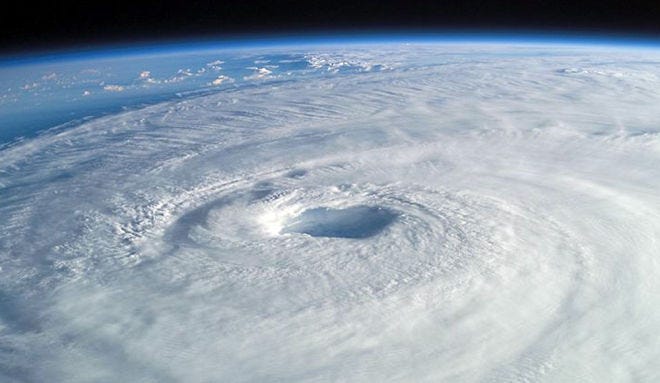
The Atlantic hurricane season began June 1, but Mother Nature started weeks ahead of schedule with Tropical Storm Arlene back in April. Though Arlene stayed out to sea, we can't count on being so lucky all season. The latest Pacific temperature data is trending towards El Niáo, but the water is not yet warm enough to qualify. The researchers at Colorado State University's Tropical Meteorology Project have revised their earlier forecast and are now predicting 13 named storms this season. Though hurricanes mostly affect offshore boaters, inland boating is also impacted when storms make landfall; even our Great Lakes home gets soaked with leftover tropical rain from time to time. As always, an ounce of prevention is worth a pound of cure. Are you prepared for hurricane season?
One of the Skipper's crew here remembers her father telling how, as a teen in 1965, he drove the family boat through the outer bands of Hurricane Betsy to safe mooring on Key Largo. A narrow escape makes a good story, but why court danger? Make an emergency plan well before you need it. Decide how and where you'll secure or store your boat if a hurricane warning is issued for your area. If your boat hurricane insurance policy requires you to move your boat out of a hurricane zone, include haul-out and storage providers in your plan and make those arrangements well before you need them.
Speaking of insurance, make sure you're covered. This one seems obvious, but in a busy life, can be easy to let the insurance slide on a vehicle you don't use every day. File a copy of your emergency plan with your insurance company, if they require it.
Can your boat ride out the storm where it's docked? Check with the marina management or harbormaster and follow their instructions to keep your boat securely moored. Besides sustaining damage itself, a loose boat tossed about by high winds and seas can destroy other vessels.
[caption id="attachment_384" align="aligncenter" width="840"] After Hurricane Andrew, 1992. Photo: Boat Owners Association of The United States[/caption]
Take a boat inventory. You can make a list or spreadsheet, or you can make a visual record with a digital or cell phone camera. Record all serial numbers. Store all boat paperwork in a safe place (not on the boat).
A hurricane warning gives you 48 hours before the storm is expected to hit. Use this time to execute your emergency plan. Remove cushions, sails, fishing equipment, radios, electronics, dinghies, and deck furniture. Lash down moving parts that you can't take off the boat (steering wheels, tillers, booms). Disconnect your boat from shore power and disconnect the battery or batteries. Stow all cords and cables in a water-resistant locker or bag.
If your boat is on a trailer, tie it down to the trailer with rope at least 1/2" thick. Move the trailered boat indoors if possible, or park and secure it to the ground on the leeward side of a building. Some experts recommend deflating the trailer's tires, too.
Docked boats must be centered in their slips. Inspect your lines for damage and replace rope if frayed or worn. Double each line and allow enough slack to accommodate the storm surge.
The movie Forrest Gump made riding out a hurricane on a boat look exciting, but in reality, it's dangerous and potentially deadly. Secure your boat, then follow evacuation orders, if issued. Don't risk your life.
Monitor NOAA Weather Radio for the latest watches, warnings, and updates during hurricane season. If a warning is issued, don't wait to act.
This short video by Florida Sea Grant shows hurricane prep for boats in action.
https://www.youtube.com/watch?v=Rdl6VCPmnME
After Hurricane Andrew, 1992. Photo: Boat Owners Association of The United States[/caption]
Take a boat inventory. You can make a list or spreadsheet, or you can make a visual record with a digital or cell phone camera. Record all serial numbers. Store all boat paperwork in a safe place (not on the boat).
A hurricane warning gives you 48 hours before the storm is expected to hit. Use this time to execute your emergency plan. Remove cushions, sails, fishing equipment, radios, electronics, dinghies, and deck furniture. Lash down moving parts that you can't take off the boat (steering wheels, tillers, booms). Disconnect your boat from shore power and disconnect the battery or batteries. Stow all cords and cables in a water-resistant locker or bag.
If your boat is on a trailer, tie it down to the trailer with rope at least 1/2" thick. Move the trailered boat indoors if possible, or park and secure it to the ground on the leeward side of a building. Some experts recommend deflating the trailer's tires, too.
Docked boats must be centered in their slips. Inspect your lines for damage and replace rope if frayed or worn. Double each line and allow enough slack to accommodate the storm surge.
The movie Forrest Gump made riding out a hurricane on a boat look exciting, but in reality, it's dangerous and potentially deadly. Secure your boat, then follow evacuation orders, if issued. Don't risk your life.
Monitor NOAA Weather Radio for the latest watches, warnings, and updates during hurricane season. If a warning is issued, don't wait to act.
This short video by Florida Sea Grant shows hurricane prep for boats in action.
https://www.youtube.com/watch?v=Rdl6VCPmnME
 After Hurricane Andrew, 1992. Photo: Boat Owners Association of The United States[/caption]
Take a boat inventory. You can make a list or spreadsheet, or you can make a visual record with a digital or cell phone camera. Record all serial numbers. Store all boat paperwork in a safe place (not on the boat).
A hurricane warning gives you 48 hours before the storm is expected to hit. Use this time to execute your emergency plan. Remove cushions, sails, fishing equipment, radios, electronics, dinghies, and deck furniture. Lash down moving parts that you can't take off the boat (steering wheels, tillers, booms). Disconnect your boat from shore power and disconnect the battery or batteries. Stow all cords and cables in a water-resistant locker or bag.
If your boat is on a trailer, tie it down to the trailer with rope at least 1/2" thick. Move the trailered boat indoors if possible, or park and secure it to the ground on the leeward side of a building. Some experts recommend deflating the trailer's tires, too.
Docked boats must be centered in their slips. Inspect your lines for damage and replace rope if frayed or worn. Double each line and allow enough slack to accommodate the storm surge.
The movie Forrest Gump made riding out a hurricane on a boat look exciting, but in reality, it's dangerous and potentially deadly. Secure your boat, then follow evacuation orders, if issued. Don't risk your life.
Monitor NOAA Weather Radio for the latest watches, warnings, and updates during hurricane season. If a warning is issued, don't wait to act.
This short video by Florida Sea Grant shows hurricane prep for boats in action.
https://www.youtube.com/watch?v=Rdl6VCPmnME
After Hurricane Andrew, 1992. Photo: Boat Owners Association of The United States[/caption]
Take a boat inventory. You can make a list or spreadsheet, or you can make a visual record with a digital or cell phone camera. Record all serial numbers. Store all boat paperwork in a safe place (not on the boat).
A hurricane warning gives you 48 hours before the storm is expected to hit. Use this time to execute your emergency plan. Remove cushions, sails, fishing equipment, radios, electronics, dinghies, and deck furniture. Lash down moving parts that you can't take off the boat (steering wheels, tillers, booms). Disconnect your boat from shore power and disconnect the battery or batteries. Stow all cords and cables in a water-resistant locker or bag.
If your boat is on a trailer, tie it down to the trailer with rope at least 1/2" thick. Move the trailered boat indoors if possible, or park and secure it to the ground on the leeward side of a building. Some experts recommend deflating the trailer's tires, too.
Docked boats must be centered in their slips. Inspect your lines for damage and replace rope if frayed or worn. Double each line and allow enough slack to accommodate the storm surge.
The movie Forrest Gump made riding out a hurricane on a boat look exciting, but in reality, it's dangerous and potentially deadly. Secure your boat, then follow evacuation orders, if issued. Don't risk your life.
Monitor NOAA Weather Radio for the latest watches, warnings, and updates during hurricane season. If a warning is issued, don't wait to act.
This short video by Florida Sea Grant shows hurricane prep for boats in action.
https://www.youtube.com/watch?v=Rdl6VCPmnME 




